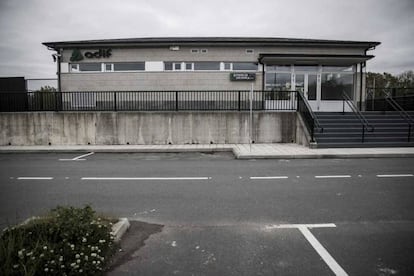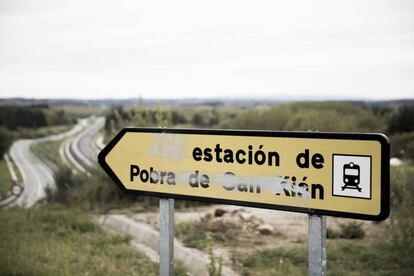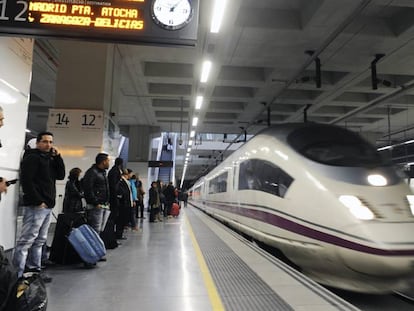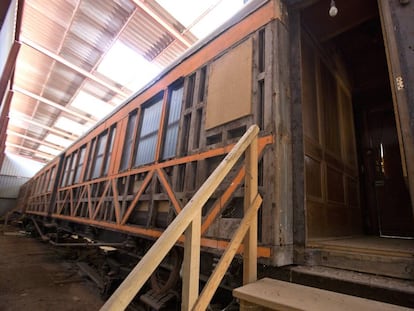A brand new high-speed AVE train station for Lugo… that can’t be used
Some €90 million was spent on the building and track in O Páramo, but it has been left without service and with no passengers

Back in Spain’s boom times, when housing developments and industrial parks were being planned all over the country, the O Páramo municipality in Lugo (Galicia), which counts on fewer than 1,500 residents, was given the great news that Spain’s high-speed AVE rail network would be coming to town. With the Popular Party (PP) in government, the Public Works Ministry decided in 2002 to build a new train station in O Páramo as part of the promised line between Ourense and Lugo, the first station in the town’s history, replacing the one in neighboring A Pobra de San Xiao, in Láncara.
There’s not a soul here who takes the train O Páramo Major Rodríguez Liz
The site chosen for the new station was Moscán, the home village of PP mayor of O Páramo, Gumersindo Rodríguez Liz. In 2006, the ministry granted funding to build the tracks and station.
But the AVE dream has since turned into a nightmare. The station and tracks are complete but there is no train service. Spanish state-owned railway operator Renfe told EL PAÍS that no one can get on or off at the station. Official sources from Renfe explain that the old station at A Pobra de San Xiao was closed in 2002 because there were not enough passengers to make it viable. “If there were no passengers before when the station was in town, there are even fewer now that it is far from here,” explained the train authority.
What’s more there is still no high-speed line between Lugo and Ourense. But even if this does come to fruition, the station at O Páramo will be of little use, given it is only 15 kilometers away from Lugo.

“There’s not a soul here who takes the train,” admitted the mayor of O Páramo, Rodríguez Liz, who says he understands Renfe’s decision not to extend its high-speed service: “Businesses have to keep profitability in mind.” But the mayor is optimistic the new station could one day be put to use. “At the time, the infrastructure works gave life to these places. Who knows? Perhaps they will not do so again in the future. We have to give it time,” he says.
The 12 months it took to complete the works is arguably a short period when compared to the still-incomplete AVE line between Lugo and Ourense. The plan to join the two regional capitals, now connected by a train that takes nearly two hours to travel the 100-kilometer distance, has not gone further than the drawing board.
The government of PP Prime Minister José María Aznar promised the high-speed line in compensation for the damage down by the Prestige tanker oil spill – Spain’s biggest environmental catastrophe. And in 2009, the premier of Galicia, Alberto Núñez Feijóo, said he would oversee the works himself from the regional government if the Socialist Party government of José Luis Rodríguez Zapatero did not give them the green light.
The station and tracks are complete but there is no train service
But with no AVE service in sight, the €90 million invested by the Public Works Ministry in the seven kilometers of train tracks and O Páramo train station have only served to improve the sluggish train service that runs between Lugo and Ourense.
According to Adif, which manages Spain’s rail infrastructure, 14 rail crossings have been removed and the station in Moscán is now only being used to store train traffic devices. “The operator is responsible for possible train service stoppages to passengers,” said Renfe. When asked how much money was spent on the station with passengers, Adif said it wasn’t possible to “individualize” the amount and claimed the details were in its “single contract.”
English version by Melissa Kitson.
Tu suscripción se está usando en otro dispositivo
¿Quieres añadir otro usuario a tu suscripción?
Si continúas leyendo en este dispositivo, no se podrá leer en el otro.
FlechaTu suscripción se está usando en otro dispositivo y solo puedes acceder a EL PAÍS desde un dispositivo a la vez.
Si quieres compartir tu cuenta, cambia tu suscripción a la modalidad Premium, así podrás añadir otro usuario. Cada uno accederá con su propia cuenta de email, lo que os permitirá personalizar vuestra experiencia en EL PAÍS.
¿Tienes una suscripción de empresa? Accede aquí para contratar más cuentas.
En el caso de no saber quién está usando tu cuenta, te recomendamos cambiar tu contraseña aquí.
Si decides continuar compartiendo tu cuenta, este mensaje se mostrará en tu dispositivo y en el de la otra persona que está usando tu cuenta de forma indefinida, afectando a tu experiencia de lectura. Puedes consultar aquí los términos y condiciones de la suscripción digital.
More information
Archived In
Últimas noticias
Maduro pleads not guilty before the federal court in New York: ‘I am still the president of Venezuela’
A new test can detect Alzheimer’s from a finger prick
UN team enters Sudanese city of El Fasher after paramilitary massacre: ‘It’s like a ghost town’
A recipe for resistance: Indigenous peoples politicize their struggles from the kitchen
Most viewed
- Gilles Lipovetsky: ‘If you want to live better and fall in love, take Prozac, don’t look to philosophy’
- Alain Aspect, Nobel laureate in physics: ‘Einstein was so smart that he would have had to recognize quantum entanglement’
- Alvin Hellerstein, a 92-year-old judge appointed by Bill Clinton, to preside over Maduro’s trial in New York
- Maduro’s downfall puts China’s relationship with Venezuela to the test
- Why oil has been at the center of Venezuela-US conflicts for decades











































